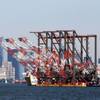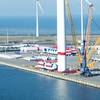Vietnam must better coordinate the planning and construction of an integrated seaport network to handle the country’s rapid trade growth, according to container transportation leader APL.
The company was providing an update of the findings outlined in a research paper, entitled: “Vietnam Transportation and Logistics: Challenges and Opportunities”, developed earlier this year by the NOL Group, the Singapore-based parent company of APL, to examine Vietnam’s transportation and logistics environment.
“Vietnam’s cargo growth potential is tremendous. Average historical growth of containerised cargo of 20% could rise to 25% per year. Previous government forecasts have underestimated actual growth of container volumes, which could have a severe impact on the future planning of cargo transportation infrastructure,” said Jim McAdam, APL’s President for the Asia Middle East region in Hanoi for the Vietnam Ports & Logistics 2007 conference.
World-class seaports will be crucial to enabling Vietnam to cope with future trade growth, according to Mr McAdam. He said new port developments must be focused around the key cargo carrying origins of Ho Chi Minh City in the south and Haiphong in the north of the country.
Vietnam’s key commercial gateway of Ho Chi Minh City, which accounts for more than 70% of Vietnam’s container throughput, is facing the most serious challenges, said Mr McAdam. Existing port and landside infrastructure is at near to full capacity and several planned new facilities will not be operational for several years.
“Congestion is a real problem in Ho Chi Minh City. There may be some relief once the first phase of new capacity comes on stream in 2009. But, if demand growth exceeds 25%, we will likely have serious under-capacity in the years ahead. The infrastructure master plan should cater not only to new port developments but also landside requirements.”
Ports in north Vietnam are facing similar infrastructure constraints. Haiphong port which currently handles around 22% of Vietnam’s container throughput is recording growth in containerised traffic in excess of 25% per year. Mr McAdam said there was a need for an additional 1 million twenty-foot equivalent units (TEU) of capacity to 2010, with demand expected to increase to 2 million TEU.
Mr McAdam said that although more than US$4.5 billion has been earmarked for new port investments over the next five years, this must be matched by a similar amount to upgrade land transportation facilities in Vietnam, which has emerged as one of the world’s leading sourcing and manufacturing locations for a range of commodities such as furniture, apparel, seafood, electronics and seafood.
With ports in Vietnam currently only able to handle relatively small vessels of between 20,000 to 30,000 deadweight tons (DWT), the need for new deepwater ports is critical to address the growing demand in the country. While the seaport master plan calls for the construction of several new deepwater ports in the country, many of these developments could be delayed due to uncoordinated planning and poor infrastructure. This is despite the interest shown by many international port operators in Vietnam.
Foreign investment and know-how must be matched by a commitment to improve cargo handling and landside facilities, logistics services, and professional skills in the shipping, ports and logistics arena.
Sponsored Content
Innovative Hull Maintenance: Profitable & Green

Subscribe for
Maritime Reporter E-News
Maritime Reporter E-News is the maritime industry's largest circulation and most authoritative ENews Service, delivered to your Email five times per week












